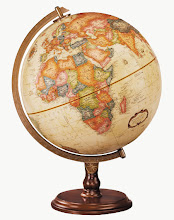We arrived at the airport around 7:50, but we weren't allowed to start the security/check-in procedure until three hours before our planes where scheduled to depart. Since my roommate's flight was earlier, we said our good-byes (in case I didn't make it through until after her flight had left), and she started the security screening at 8:30 while I sat and waited for another hour.
After sitting in the uncomfortable seats with all my luggage for almost two hours, I was finally able to line up for the first round of security. While standing in line, everyone gets questioned by security guards who also check your passport. The security agent I got asked a few basic questions (how long was I in Israel, what was I doing, etc.) while she flipped casually through my passport ... then she got an odd look on her face and started going through the passport again, this time a lot slower and stopping when she got to the page with the stamps from South Sudan. She then asked if I spoke Hebrew (no) and told me to wait there and walked off to the security desk with my passport. She came back a few minutes later, asked some of the same questions, including if I spoke Hebrew, and then some other girl came up and chatted with her in Hebrew for a while. I'm not sure what it was about, but I have a feeling it was to see whether or not I really spoke Hebrew or not!
A guy twice her size then came up and took my passport from her, and asked me the same questions again. Then started questioning the South Sudan stamps: Why are there so many? Why were you there? Where did you stay? I was getting some odd looks from the other people in the line ... they just got the basic questions like "did you pack your bags yourself?" He was finally satisfied, stuck stickers on my bags and passports, and then I continued with the line to get my checked bag x-rayed. My sticker started with a 5 ... on their scale of security risks, 1 is no threat, 6 is high threat ... apparently, I'm dangerous!
Most bags, after flying out the other side of the x-ray machine (they were airborne for about a meter!), got a security tag attached to them ... I was sent to another area to have my bag searched. It took about 20 minutes for the lady to go through all the stuff in my bag, swabbing everything and testing for explosives, I assume. Since I knew that I had plenty of time before my flight left (it was advertising that it was going to be an hour delayed), I didn't really care - it's for my own safety that they do all these checks. After everything got swabbed, she watched my pack up the bag and escorted me past the line-ups to the check-in counter. Again, I got some odd looks from the other passengers waiting in line - how come I got to jump the line? and why was I accompanied my a guard? She finally left after my luggage was checked-in, and I headed off to the next security inspection.
The next security check was closer to what is at every airport - my carry-on bag went through and x-ray machine (though they really take their time to inspect the images before the bag comes out), my boots and passport were swabbed. The big difference was that there were 6 armed security guards watching the whole thing and a big 5 sticker was put on my backpack ... just to make me feel special, I guess. I had no questions at immigration, just a stamp in the passport, and I was off to find my roommate. She also rated a 5! We chatted a bit, then she boarded her flight and I went off to find some food - I can only last on granola bars for so long.
It was a long wait at the airport - at 12:30 when the flight was originally supposed to depart, the plane hadn't even landed yet! It ended up leaving around 2 pm. Ben Gurion is a fairly nice airport - very clean and modern. But I had to laugh at their no smoking announcements - with the accent, it sounded more like they were saying "Your attention please. 'Smuggling' is permitted only in the designated areas." This is also the only airport where I've heard the announcement that "Weapons are not allowed in the terminal area."
The flight finally left, and I managed to have an empty seat beside me so I could spread out a bit. The flights was long (12 hours) but uneventful. My brother-in-law and niece met me at the airport and I stopped by my sister's place to chat a bit about Israel and to have a snack before finally going home.
































 Joshua didn't conquer
Joshua didn't conquer 






